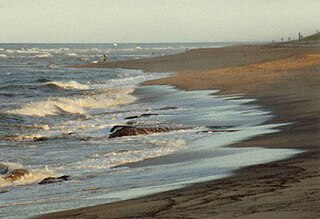
Cape Cod is an arm-shaped peninsula extending into the Atlantic Ocean from the southeastern corner of Massachusetts, in the northeastern United States. Its historic, maritime character and ample beaches attract heavy tourism during the summer months. The name Cape Cod, coined in 1602 by Bartholomew Gosnold, is the ninth oldest English place-name in the U.S.

Barnstable County is a county located in the U.S. state of Massachusetts. At the 2020 census, the population was 228,996. Its county seat is Barnstable. The county consists of Cape Cod and associated islands.

The Cape Cod Baseball League is a collegiate summer baseball wooden bat league located on Cape Cod in the U.S. state of Massachusetts. One of the nation's premier collegiate summer leagues, the league boasts over one thousand former players who have gone on to play in the major leagues.

Monomoy Island is an 8-mile-long (13-kilometre) spit of sand extending southwest from Chatham, Cape Cod off the Massachusetts mainland. Because of shifting sands and water levels, it is often connected to the mainland, and at other times is separated from it. It is home to the Monomoy National Wildlife Refuge. It is referred to in the 1691 Massachusetts Charter as Cape Mallabar, also spelled Cape Malabar.
Graveyard of the Atlantic is a nickname for the treacherous waters and area of numerous shipwrecks off the Outer Banks of North Carolina, United States, which are due to the coast's shifting sands and inlets. To a lesser degree, this nickname has also been applied to Sable Island off of Nova Scotia, Canada, as well as the waters off Cape Cod, Massachusetts, United States.
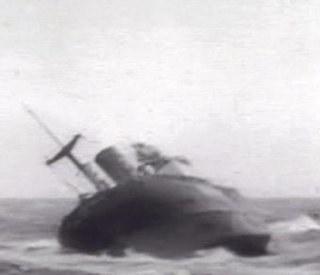
SS Flying Enterprise was a 6,711 ton Type C1-B ship which sank off Cornwall in 1952. She was built in 1944 as SS Cape Kumukaki for the United States Maritime Commission for use in World War II. The ship was sold in 1947 and then operated in scheduled service under the name Flying Enterprise.
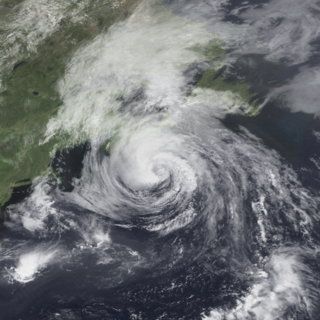
Hurricane Bertha caused minor damage in the United States, Bermuda, and Atlantic Canada in July and August 1990. The third tropical cyclone, second named storm, and first hurricane of the 1990 Atlantic hurricane season, Bertha developed from a frontal low pressure area offshore of North Carolina on July 24. Initially subtropical, it slowly acquired tropical characteristics while tracked southeast and then southwestward. By early on July 27, the cyclone was re-classified as a tropical depression. Following its transition, the depression intensified and was upgraded to Tropical Storm Bertha on July 28. The storm then curved northeastward and rapidly strengthened. Bertha became a hurricane early on July 29, though it weakened back to a tropical storm later that day. On the following day, Bertha re-intensified into a hurricane and peaked as an 80 mph (130 km/h) Category 1 hurricane on July 31.

The Harwich Mariners are a collegiate summer baseball team based in Harwich, Massachusetts. The team is a member of the Cape Cod Baseball League (CCBL) and plays in the league's East Division. The Mariners play their home games at Whitehouse Field in the historic village of Harwich Center.

The SS Regina was a cargo ship built for the Merchant Mutual Line and home ported in Montreal, Quebec. Named after Regina, Saskatchewan, Regina had a tonnage of 1,956 gross register tons (GRT) and a crew of 32.
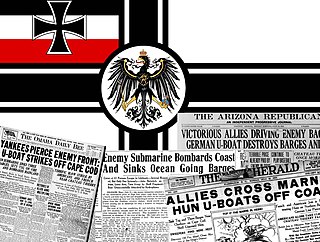
The attack on Orleans was a naval and air action during World War I on 21 July 1918 when a German submarine fired on a small convoy of barges led by a tugboat off Orleans, Massachusetts, on the eastern coast of the Cape Cod peninsula. Several shells fired during the engagement likely missed their intended maritime or aircraft targets and fell to earth in the area around Orleans, giving the impression of a deliberate attack on the town.

HMS Niger was a Halcyon-class minesweeper of the Royal Navy. She was launched in 1936 and was sunk during the Second World War. On 5 July 1942, the vessel sailed into a minefield while escorting Convoy QP 13 and struck one of the mines, later sinking with only eight survivors.

Hurricane How was the only tropical cyclone to make landfall on the United States in 1951. It was the eighth storm of the season, forming on September 28 in the northwest Caribbean and, after entering the Gulf of Mexico, turned eastward and became a tropical storm. The storm brought heavy rainfall to Florida, causing flooding and $2 million in damage. Tropical Storm How later became a hurricane, passing near the Outer Banks of North Carolina where it produced strong winds and high tides. A ship called the "Southern Isles" capsized off Cape Hatteras, killing 17 out of the crew of 23. Rains and high tides occurred in southeastern New England, before the hurricane moved out to sea and became extratropical.

The February 1952 nor'easter was a significant winter storm that impacted the New England region of the United States. The storm ranked as Category 1, or "notable", on the Northeast Snowfall Impact Scale. Its rapid intensification resulted in heavy snowfall between February 17 and 18, accumulating to 12 to 30 inches. High winds also affected central and northern New England. The nor'easter is estimated to have caused 42 fatalities. In Maine, over 1,000 travelers became stranded on roadways. Two ships cracked in two offshore New England during the storm.

Hurricane Josephine was a long-lived Atlantic hurricane that threatened the East Coast of the United States for several days in October 1984. The sixteenth tropical cyclone, tenth named storm, and third hurricane of the season, Josephine developed from an area of disturbed weather near the Bahamas on October 7, forming with subtropical characteristics. It quickly organized, and gained tropical characteristics as it strengthened into a tropical storm on October 8. Gradual intensification occurred thereafter, reaching hurricane status on October 10. The storm headed northward, remaining well offshore of the eastern United States. Josephine strengthened further and peaked as a moderately strong Category 2 hurricane on the Saffir-Simpson Hurricane Scale on October 12. On the following day, Josephine weakened back to a Category 1 hurricane before becoming nearly stationary. It later headed northeastward and paralleled the coast well offshore of Nova Scotia. By October 17, Josephine weakened back to a tropical storm, shortly before beginning to execute a cyclonic loop to the south of Newfoundland. While executing the cyclonic loop, Josephine became extratropical on October 18.

The Sparrow-Hawk was a 'small pinnace' similar to the full-rigged pinnace Virginia that sailed for the English Colonies in June 1626. She is the earliest ship to participate in the first decades of English settlement in the New World to have survived to the present day.

MV Canadian Miner was a Canadian laker that was part of the fleet of Upper Lakes Shipping from 1994–2011. Initially constructed as Maplecliffe Hall in 1966, the ship was renamed Lemoyne in 1988 before becoming Canadian Miner in 1994. In 2011, the name was shortened to just Miner. In 2011 the vessel was taken out of service and sold for scrapping. While en route to the scrapyard in Turkey, the ship ran aground off Nova Scotia in 2011. The vessel was broken up in 2014 in Nova Scotia.
Jeremiah's Gutter, also called Jeremy’s Dream was a canal located on the border of Orleans and Eastham, Massachusetts, the first canal to cut across the peninsula of Cape Cod. It connected Cape Cod Bay in the west to the Atlantic Ocean in the east. It was active for over 100 years, although it gradually fell out of use and was replaced by the Cape Cod Canal.
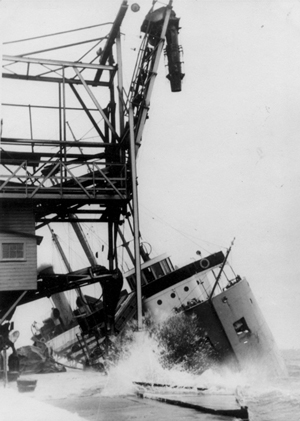
SS Brulin was a lake freighter that worked the North American Great Lakes routes from 1924 to 1960. She was renamed Outarde in 1939, and James J. Buckler in 1960, shortly before she ran aground and sank during salvage operations. Brulin was built by Palmers Shipbuilding and Iron Company, Hebburn-on-Tyne and launched on 31 July 1924, for the Montreal Forwarding Company. She was built to the maximum dimensions of the canal locks that preceded the St Lawrence Seaway.
Rock Harbor is a man-made harbor on Cape Cod Bay located on the border between Orleans, Massachusetts and Eastham, Massachusetts.

Racer's hurricane was a destructive tropical cyclone that had severe effects in northeastern Mexico, the Republic of Texas, and the Gulf Coast of the United States in early October 1837. It was named after the Royal Navy ship HMS Racer, which encountered the cyclone in the northwestern Caribbean. Termed "one of the most famous and destructive hurricanes of the century" by meteorology historian David Ludlum, the storm first affected Jamaica with flooding rainfall and strong winds on September 26 and 27, before entering the Gulf of Mexico by October 1. As the hurricane struck northern Tamaulipas and southern Texas, it slowed to a crawl and turned sharply northeastward. The storm battered the Gulf Coast from Texas to the Florida Panhandle between October 3 and 7. After crossing the Southeastern United States, it emerged into the Atlantic shipping lanes off the Carolinas by October 9.

















